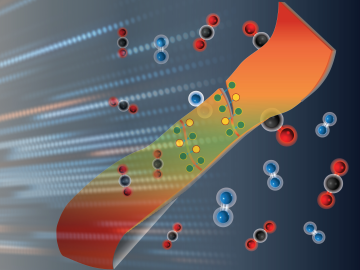
Filter News
Area of Research
- (-) Advanced Manufacturing (7)
- (-) Materials (56)
- Biology and Environment (9)
- Computer Science (1)
- Electricity and Smart Grid (1)
- Energy Science (30)
- Functional Materials for Energy (1)
- Fusion and Fission (4)
- Fusion Energy (2)
- Isotopes (7)
- Materials Characterization (1)
- Materials for Computing (11)
- Materials Under Extremes (1)
- National Security (5)
- Neutron Science (12)
- Nuclear Science and Technology (2)
- Quantum information Science (4)
- Supercomputing (12)
- Transportation Systems (1)
News Type
News Topics
- (-) Composites (8)
- (-) Cybersecurity (2)
- (-) Isotopes (4)
- (-) Materials Science (33)
- (-) Microscopy (14)
- (-) Physics (7)
- (-) Polymers (8)
- (-) Quantum Science (2)
- 3-D Printing/Advanced Manufacturing (22)
- Advanced Reactors (3)
- Artificial Intelligence (3)
- Bioenergy (5)
- Biology (2)
- Biomedical (2)
- Buildings (2)
- Chemical Sciences (11)
- Clean Water (1)
- Computer Science (5)
- Coronavirus (1)
- Critical Materials (6)
- Energy Storage (16)
- Environment (5)
- Frontier (2)
- Fusion (4)
- Grid (1)
- High-Performance Computing (2)
- Irradiation (1)
- ITER (1)
- Machine Learning (2)
- Materials (39)
- Molten Salt (2)
- Nanotechnology (17)
- National Security (1)
- Neutron Science (8)
- Nuclear Energy (5)
- Partnerships (2)
- Quantum Computing (2)
- Simulation (1)
- Space Exploration (2)
- Transportation (9)
Media Contacts

OAK RIDGE, Tenn., March 22, 2019 – Karren Leslie More, a researcher at the Department of Energy’s Oak Ridge National Laboratory, has been elected fellow of the Microscopy Society of America (MSA) professional organization.

Scientists have tested a novel heat-shielding graphite foam, originally created at Oak Ridge National Laboratory, at Germany’s Wendelstein 7-X stellarator with promising results for use in plasma-facing components of fusion reactors.

Oak Ridge National Laboratory scientists studying fuel cells as a potential alternative to internal combustion engines used sophisticated electron microscopy to investigate the benefits of replacing high-cost platinum with a lower cost, carbon-nitrogen-manganese-based catalyst.
Physicists turned to the “doubly magic” tin isotope Sn-132, colliding it with a target at Oak Ridge National Laboratory to assess its properties as it lost a neutron to become Sn-131.

Three researchers from the Department of Energy’s Oak Ridge National Laboratory have been elected fellows of the American Physical Society (APS). Fellows of the APS are recognized for their exceptional contributions to the physics enterprise in outstanding resear...

An Oak Ridge National Laboratory-led team used a scanning transmission electron microscope to selectively position single atoms below a crystal’s surface for the first time.

Oak Ridge National Laboratory scientists have improved a mixture of materials used to 3D print permanent magnets with increased density, which could yield longer lasting, better performing magnets for electric motors, sensors and vehicle applications. Building on previous research, ...

An Oak Ridge National Laboratory–led team has developed super-stretchy polymers with amazing self-healing abilities that could lead to longer-lasting consumer products.

A shield assembly that protects an instrument measuring ion and electron fluxes for a NASA mission to touch the Sun was tested in extreme experimental environments at Oak Ridge National Laboratory—and passed with flying colors. Components aboard Parker Solar Probe, which will endure th...

A novel method developed at Oak Ridge National Laboratory creates supertough renewable plastic with improved manufacturability. Working with polylactic acid, a biobased plastic often used in packaging, textiles, biomedical implants and 3D printing, the research team added tiny amo...


